How to Identify Bald Eagle Feathers
There’s nothing quite like seeing a bald eagle flying overhead to inspire the imagination. Even outside of America, which has an obviously tight connection with the bird, the eagle is a beloved species with many admirers. Its symbolism is diverse and spread throughout many parts of various cultures.
As a result, there’s always a lot of excitement whenever somebody finds what may or may not be an eagle feather. How do you know for sure if you’ve found a feather from this sometimes elusive bird? Let’s look at a few important (and fun) facts to learn more!
Note, while we are focusing on bald eagles in this post, most eagles have similar feathers.
How Do You Tell If It’s an Eagle Feather?
There’s nothing more exciting than finding a large feather near an eagle nesting area! But how do you know for sure that you’ve found the real thing? After all, feathers can be quite complex in their coloring. The various feather types on an eagle’s body work together to create their coloring and may look very different from what you’d expect looking at an eagle at rest.
As a result, it is important to break down the various feather types that exist on an eagle and discuss their length and coloring patterns. Thankfully, most eagle feathers are fairly uniform in color and shape, especially those of bald eagles. In the following bullet list, we’ll highlight what eagle wing feathers look like, as well as other important feathers that may easily fall off their body:
Primary Wing Feathers
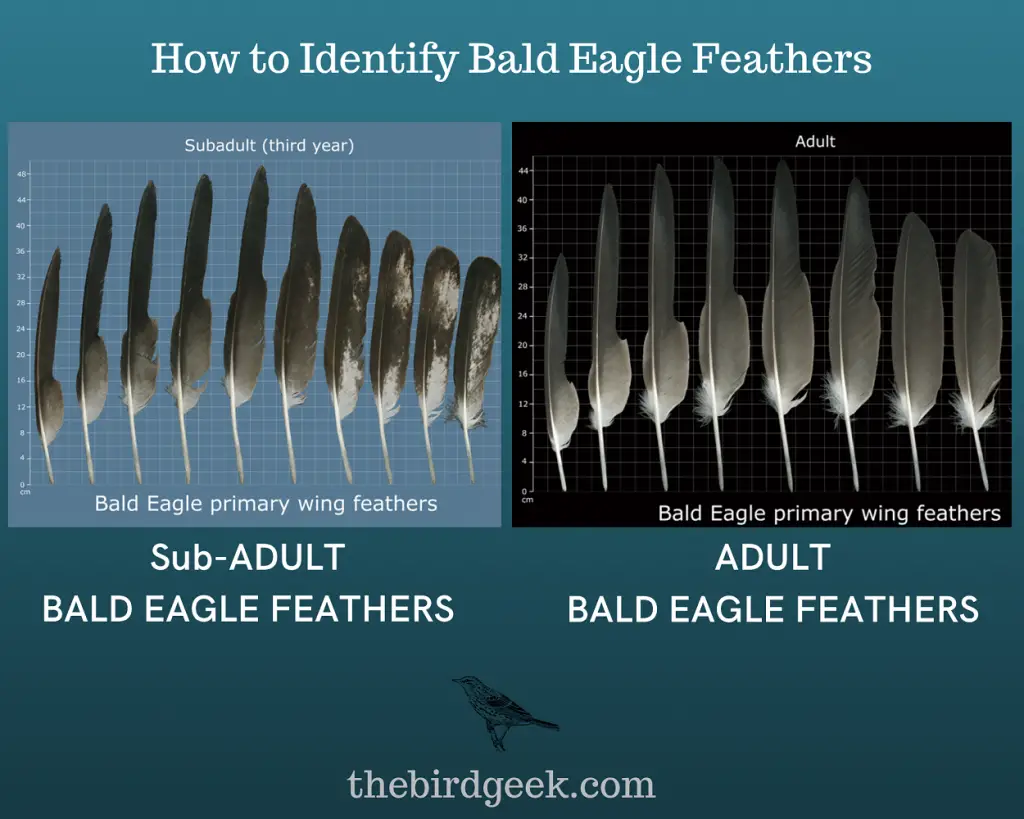
Primary wing feathers are often the longest wings on an Eagle’s body. They help provide maximum lift and control when flying and are between 32-44 centimeters or 12-17 inches long in a full-grown adult. They are typically dark gray at the narrow tip for most of their length before widening out at the base and lightening to white toward the feather’s tip.
Related post: How To Identify Red Tailed Hawk Feathers
Secondary Wing Feathers
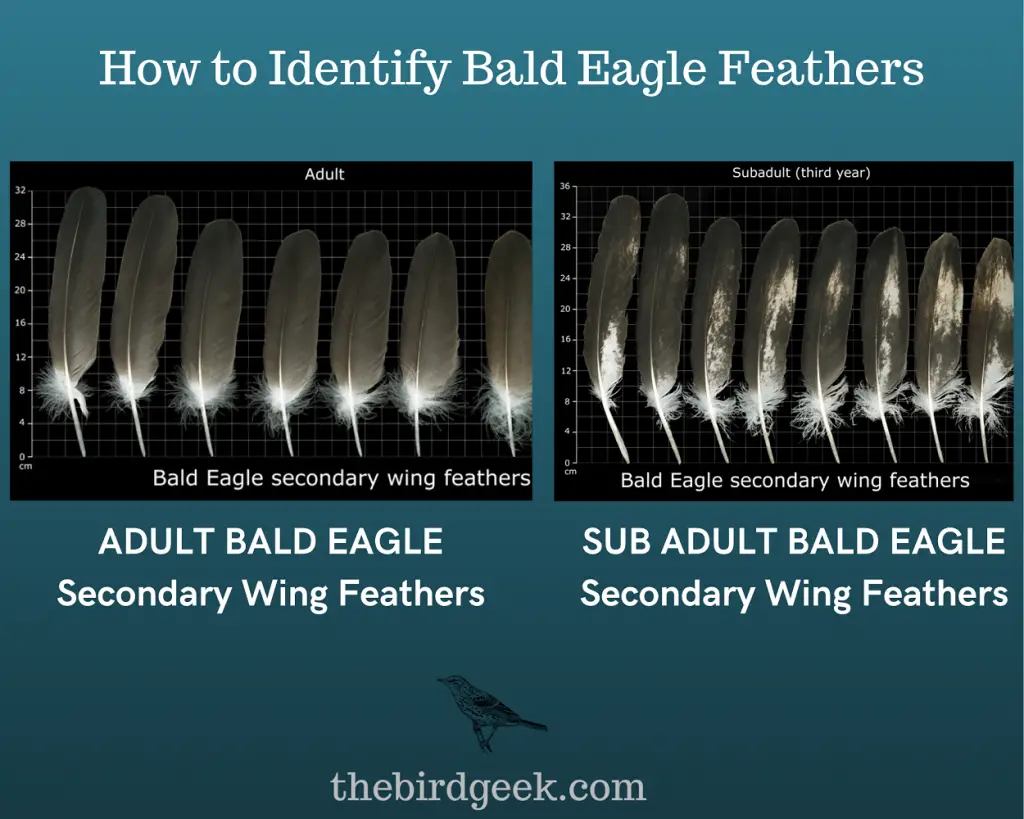
An eagle’s secondary wing feathers are shorter but broader feathers that exist just beneath the primary feathers. They help with control and lift and give an eagle maximum turning capacity. They range from about 28-32 centimeters or 11-12 inches in length. They have a fairly dark color that veers towards black but whitens up towards the base at the tip.
Axillary and Covert Feathers
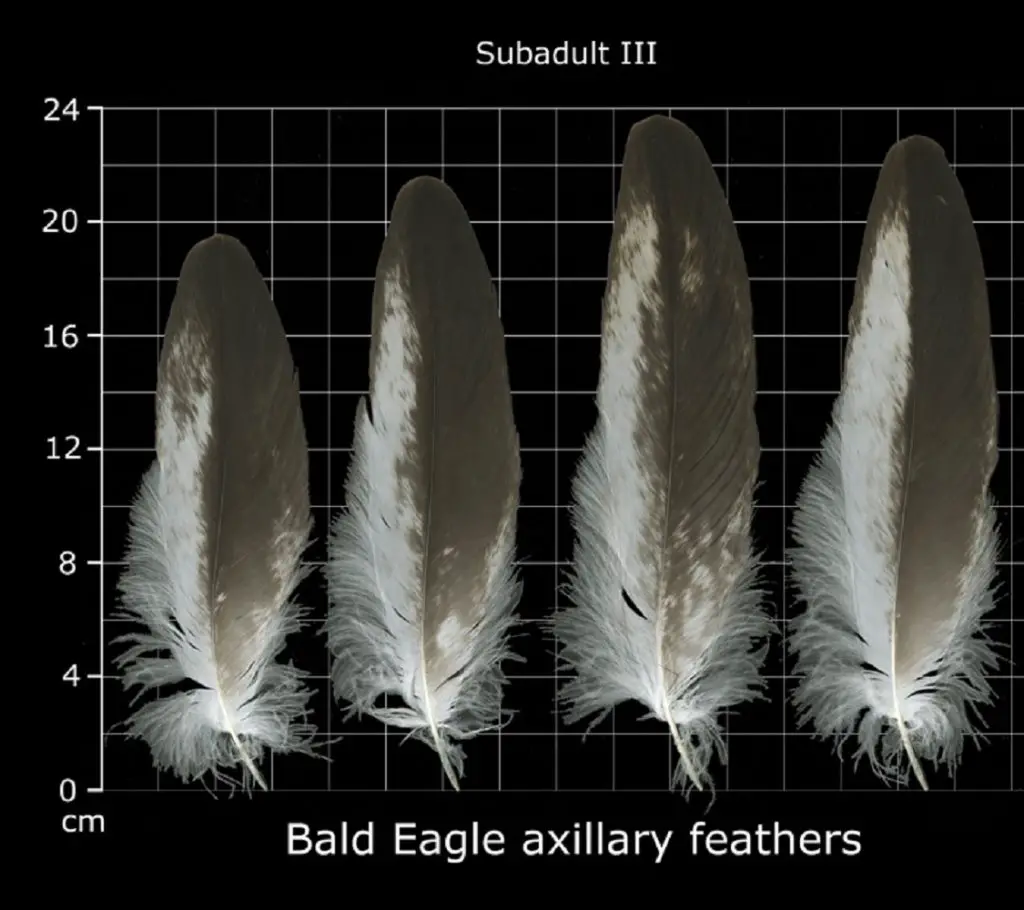
These shorter and broader feathers are typically between 20-24 centimeters or 7.8-9.4 inches long. They provide extra insulation to a bird’s body that helps them stay warm and cool in appropriate seasons. They typically have a black tip that splits into a white section that runs along the interior edge. The bottom is fairly “fluffy” compared to other feathers.
Tail Feathers
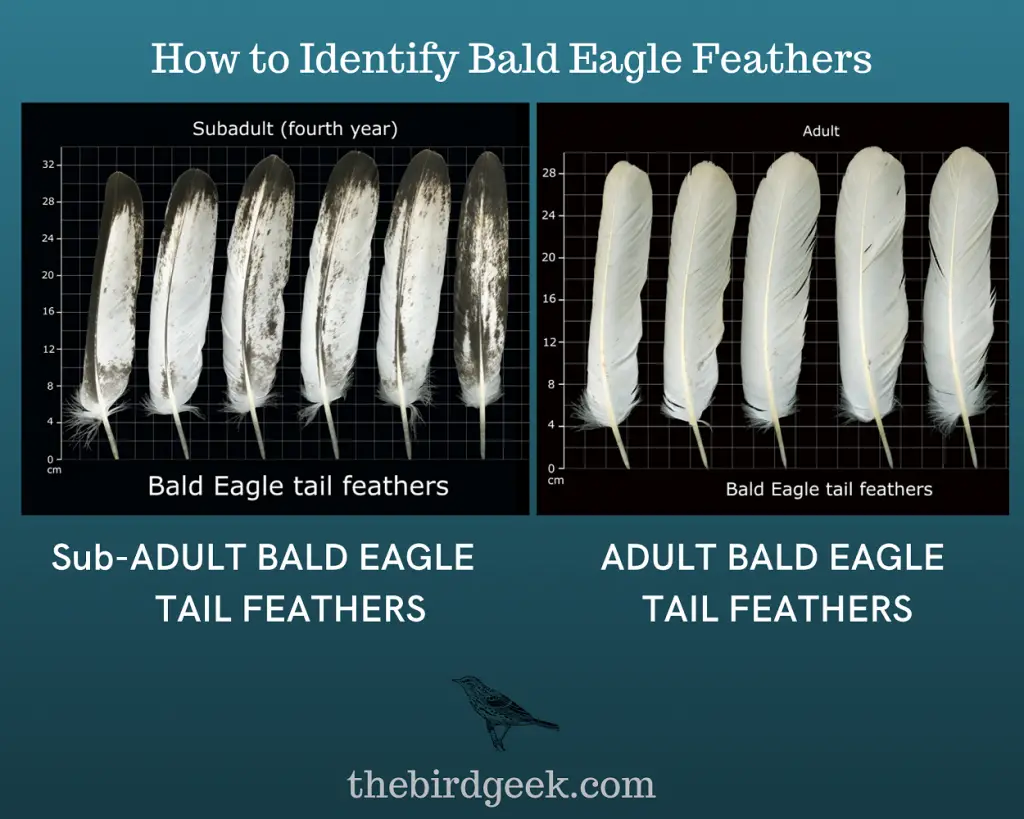
Images courtesy of the US Fish and Wildlife Service Feather Atlas
An eagle’s tail feathers are typically about the same overall size and shape as secondary wing feathers and help eagles make the quick pivoting actions necessary to catch clever prey. They may be more spotted than other feathers on an eagle’s body. For example, they may include extensive white patches among the dark gray, which varies depending on the feather. However, variations are common. Many adult bald eagles have white tail feathers.
Eagle feathers may look different based on the eagle’s age
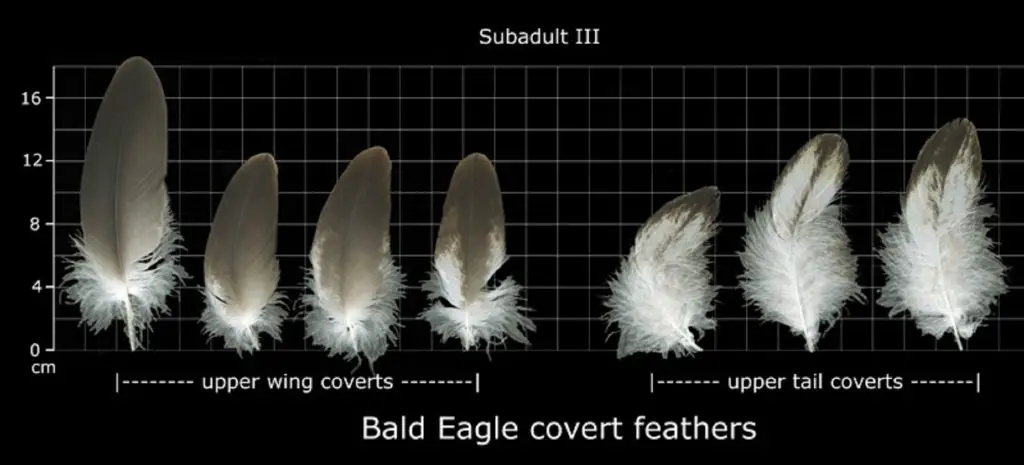
Please note that these feathers may change slightly in appearance as the eagle ages. For example, juvenile eagles typically have whiter feathers with a “fluffier” appearance similar to down. Their feathers are also much shorter. Subadult eagles (between 1-4 years, depending on the specific eagle) also vary slightly in color and pattern, depending on their age.
These differences should be minor, however, and the patterns mentioned above should be pretty similar throughout. Note that younger eagles will have feathers at least half the size of full-grown adults, though. This should help you understand whether the feathers you found around an alleged eagle nesting area are genuinely from this bird.
Related post: How To Identify Turkey Feathers
How Can You Tell If an Eagle Feather is Real?
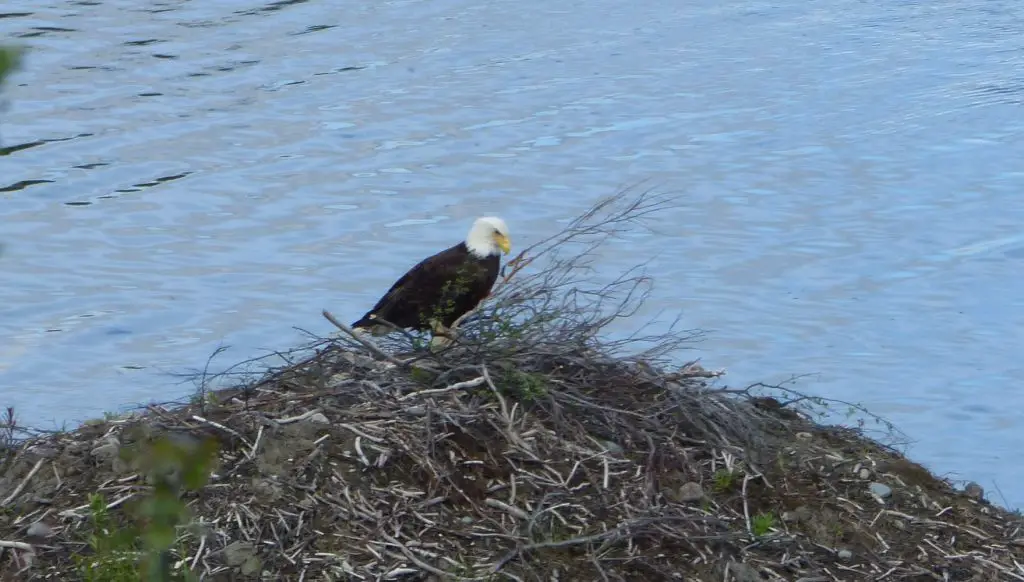
If you ever go to a specialty store and find that they are selling “authentic Eagle feathers,” it is important to know whether they are real. Unfortunately, unless you’re in Native American stores that sell such items, there’s not much chance that your eagle feather is real. That’s because most “authentic” eagle feathers found in non-native stores are dyed turkey feathers.
The reasons for this scam are obvious. Eagles are very popular birds, particularly in America, and people may want a feather to celebrate their connection with this bird. But why is it virtually guaranteed that any eagle feather being sold outside Native shops is a dyed turkey feather? Well, there are a few laws that make it illegal for non-Natives to own or sell eagle feathers.
Understanding These Laws
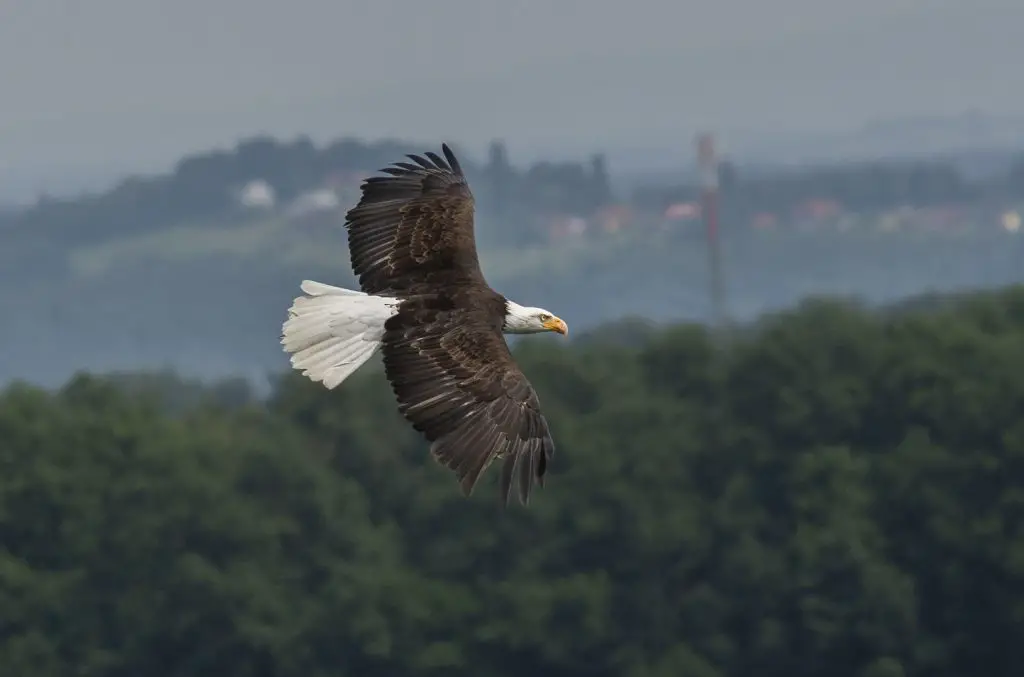
Two different laws forbid people from possessing eagle feathers, though their scope goes far beyond this simple facet. The Migratory Bird Treaty Act of 1918 makes it illegal to kill, sell, buy, or possess a bird covered by the treaty. It is also illegal to possess any part of these birds, such as a feather. Eagles are among the many, many birds covered under this treaty (few birds are not protected in this way).
Now, if you live outside of countries that don’t have this law (the United States, Canada, Mexico, Japan, and Russia are all covered by the law), you may be able to buy, sell, or possess eagle feathers, depending on the region. But if you live within their borders, even buying an eagle feather legally elsewhere and bringing it back to your home country could result in legal fines and even jail time for repeated offenses.
Furthermore, eagles are protected (in America) by the Bald and Golden Eagle Protection Act of 1940. This law makes it illegal to pursue, shoot, poison, wound, capture, trap, collect, “molest”, or disturb a bald or golden eagle. You also cannot buy or own any part of an eagle, including an eagle feather. Even one found on the ground that doesn’t hurt the bird to collect is considered illegal.
Native Exceptions
You probably noticed that we mentioned Native Americans could sell eagle feathers. That’s because federally recognized tribes may have religious and cultural connections to eagles that the migratory act recognizes. As a result, eligible Native Americans can get a permit to own and receive eagle feathers. They can even give eagle feathers to other eligible Native Americans.
Note that it is illegal for them to sell eagle feathers to non-Native Americans or even ineligible Native Americans. So if you go to a Native American store and they offer to sell you a feather, it is better just to leave and report them to the proper authorities. Otherwise, you might get in legal trouble if they decide to turn you in for possessing one.
Signs a Feather is Fake
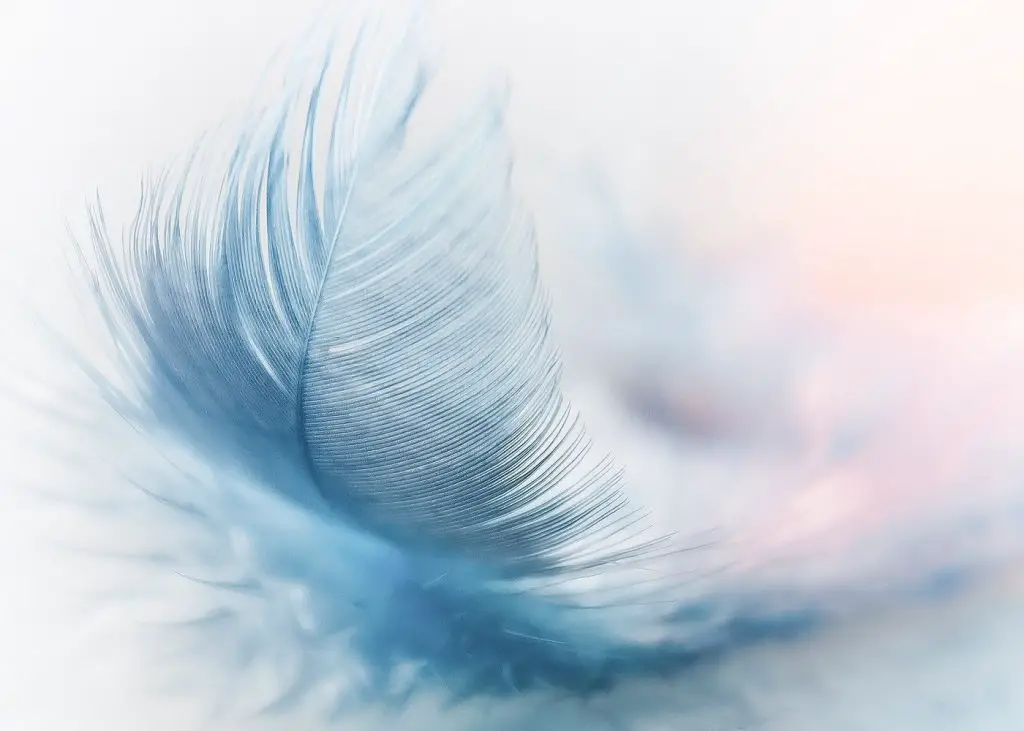
If you bought or found an eagle feather, here are a few signs it is fake:
- It feels rather stiff or sharp, as eagle feathers are relatively soft
- You notice color coming off your hand when you hold the feather
- The edges are uneven or rough, as eagle feathers are smooth
- Its far too short based on the listings above
Related post: How To Identify Owl Feathers
Can I Keep an Eagle Feather I Found?
No, you cannot and should not keep an eagle feather you found. As mentioned in depth in the previous section, owning an eagle feather violates the Migratory Bird Treaty Act of 1918 and is punishable by fines and even jail time. Even if you find an eagle feather on the ground and did not hurt the bird, possessing this feather is illegal. Though you’re not likely to be caught, fines are rather steep and not worth it.
What Should I Do If I Find an Eagle Feather?
When you find an eagle feather, the best thing to do is take a picture of it to keep it in your memories. Don’t pick it up or take it with you! You may also call animal control experts in your area to learn more about potential eagle sightings in the area and what they may do to help improve the eagle population. You can also contact Native tribes in your area to see if they want the feather. Report its location and let them pick it up. Again: never take an eagle feather from where you find it!
Related posts: How To Identify Osprey Feathers
What Does Finding an Eagle Feather Mean?
Eagles are consistently connected to higher meaning and spiritual strength. They fly incredibly high, which hasn’t been lost on cultures over the years. Their ability to fly so high has made them akin to spiritual messengers, as well as courage, respect, and humility. Eagles were a common symbol of many gods and as such, were a symbol of inspiration, loyalty, honesty, and truth.
Eagle feathers may also symbolize balance because they have two sides that are roughly equivalent in shape and coloring. Eagles also represent balance through their fantastic flying and hunting skills. If you find an eagle feather, it may symbolize the universe trying to communicate the importance of spiritual connection to a higher being or of connecting with your higher self.
Finding an eagle feather may also symbolize the importance of making wise decisions and not choosing rashly when deciding. Known to be intelligent and skilled hunters, eagles are heavily connected with wisdom and decisiveness. The universe may be telling you that the decisions you are making now are wise and encouraging you to stick with them, even if they seem hard at first.
Related post: The Coolest Birds
Wrap UP – How to Identify Bald Eagle Feathers
We hope you’ve learned about how to identify bald eagle feathers. Please come back whenever you need to refresh your memory or when you have a feather to identify!
If you’re looking for more resources on identifying eagle feathers, the US Fish and Wildlife Services have an exhaustive collection of photos of various bird feathers, and even an “identify my feather” tool on their site here.
Related post: How To Identify Goose Feathers
